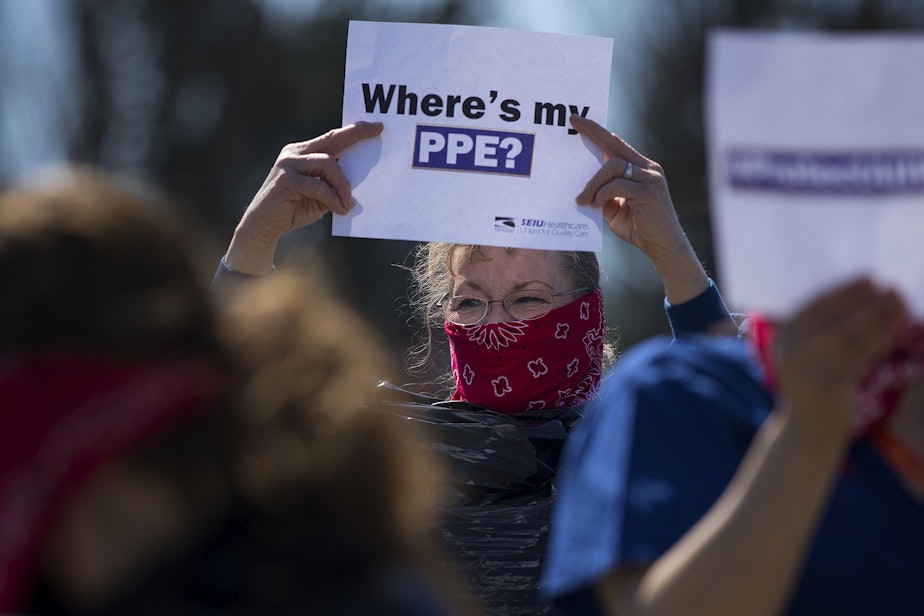Beware the Lysol quarantini: Why health workers must quash misinformation during this coronavirus pandemic

Elisabeth Poorman is a doctor of internal medicine in the Seattle area. Follow her on Twitter @DrPoorman.
As the coronavirus pandemic has spread around the globe, I find myself, as a doctor, dealing with another viral spread –information. Good information, bad information, and very dangerous information.
Until the president suggested that injecting household cleaners could cure coronavirus, my biggest concern was the rise in alcohol consumption as people battle their fears and anxieties without healthy outlets.
Even at supposedly “safe” levels, alcohol has been linked to an increased risk of cancer, dementia, and insomnia.
The rise in alcohol consumption during the pandemic is a serious problem, not least because it actually suppresses your immune system.
While alcohol is a key ingredient in many sanitizers, killing viruses on surfaces and our skin, it kills indiscriminately when we ingest it (the same can be said of Lysol, of course).
Sponsored
When alcohol travels through our digestive system, before it is absorbed, it disrupts the natural microbiome in our gut that protects us from viruses and bacteria. It also suppresses bone marrow where new blood cells are made, including the ones that fight infection. Indeed, people who drink heavily often have low white blood cell counts and are prone to lung infections.
Nonetheless, Youtube videos of “quarantini” videos have proliferated, with bubbly hosts adding packets of (probably useless) vitamin C powder to gin.
Even more dangerous remedies are spreading among the desperate. Even before the president’s remarks, people had taken to drinking bleach -- believing this would prevent them from getting sick -- leading poison control centers to put out press releases warning that this could be deadly.
Then there was a married couple in Arizona hospitalized after taking what they mistakenly believed was hydroxychloroquine (initially called a miracle cure by government officials, but probably ineffective). Instead, the compound was an aquarium cleaner.
And dozens of people in Iran, where the government has been loath to share information with its citizens, died after drinking bootleg alcohol touted as a cure.
Sponsored
More Americans get their information from social media than any other source. This presents unique public health challenges. In the early stages of this pandemic, the World Health Organization warned that governments had to fight a pandemic and a massive infodemic, a proliferation of mistruths and conspiracy theories, making it difficult for people to find reliable facts and guidance.
In those early days, I saw friends from medical school and medical residency -- who rarely share anything on social media -- posting helpful, and alarming, reports on Facebook, Twitter, and Instagram. These posts from health care providers, I believe, were vital in warning the public about the dangers of coronavirus while government messaging remained muddled.
Not every post was accurate, especially at the beginning when even many of us health care workers had a hard time wrapping our head around what was coming -- a pandemic unprecedented in the previous century. It’s something our training could not have prepared us for.
Even inaccurate posts, though, were an opportunity for discussion, to communicate with friends and colleagues in other parts of the country about the reality of the outbreak in places hit early. Places like Seattle. I believe our desperate pleas for others to take this seriously saved lives.
But many health care workers are afraid to share their firsthand experience, and for good reason. Far from treating this public outreach as a service to the community, traditional academic medicine often treats good communicators with disdain, even labeling them “Kardashians” for embracing social media (the Kardashians, ironically, have been important advocates of social distancing).
Sponsored
Many hospital administrators, meanwhile, have reprimanded or even fired health care workers for sharing their opinions. Such reactions are not unexpected from increasingly corporate healthcare systems intent on protecting their brand.
But in a pandemic, these actions stoke the kind of mistrust that makes frontline workers afraid to speak up about unsafe conditions, or engage with a frightened public. Our silence allows other voices to proliferate on the platforms our patients are turning to, and spread dangerous misinformation unchecked.
Sharing on social media has the potential reach patients, and to open up conversations that hospital systems are often loathe to have: about patient and staff safety, about discrimination, and the ways we fail to serve the underserved. In times when information sharing is critical -- as it is now -- it is a vital public service.
While more and more providers see part of their role to educate the public, and even institutions have embraced the importance of social media for keeping the public informed, the old guard is still skeptical. Doctors should be stoic and little heard, they say. Silent. Heroic. Perfect. Inhuman.
Transparency, according to the World Health Organization, is the core of pandemic response. Governments and organizations, they note, are often unwilling to share information because of a tendency to tightly control information amid fears of the economic impact and uncertainty.
Sponsored
Many of our health care institutions are facing similar pitfalls. Instead of examining how we share information, many are reprimanding and silencing their employees, and undermining their colleagues’ efforts to combat misinformation.
There is no greater test of a policy than a pandemic. Now is our best chance for considering how our policies of information sharing can keep the public informed in times of crisis. We can even train and reward good communicators for this valuable service.
Or we can continue to allow conspiracy theories and miracle cocktails to spread faster than a virus.



